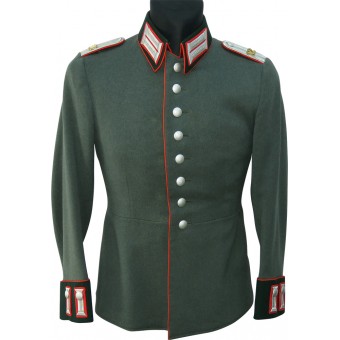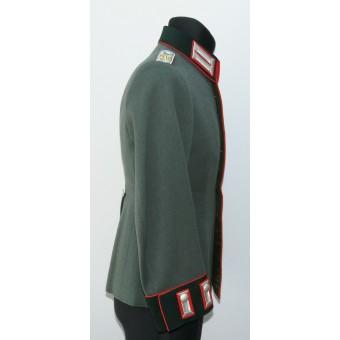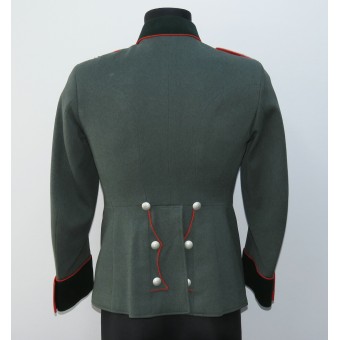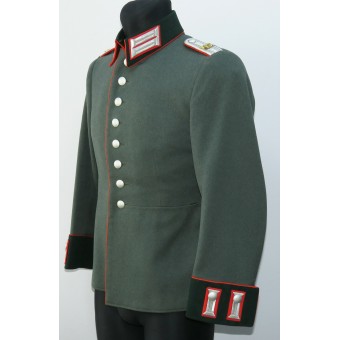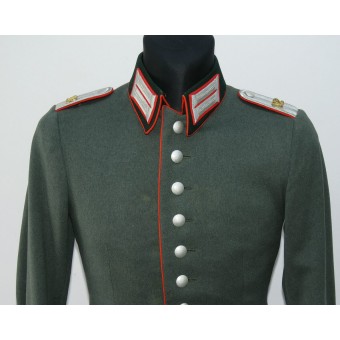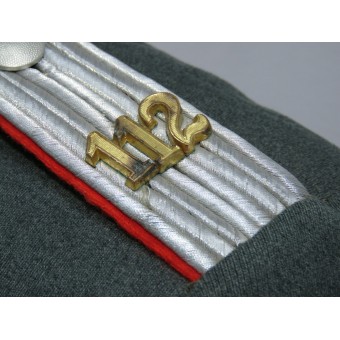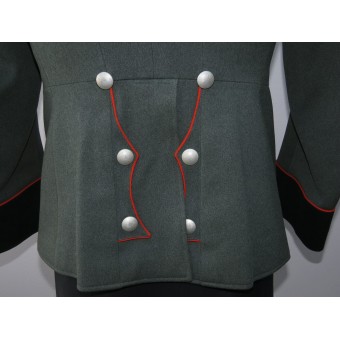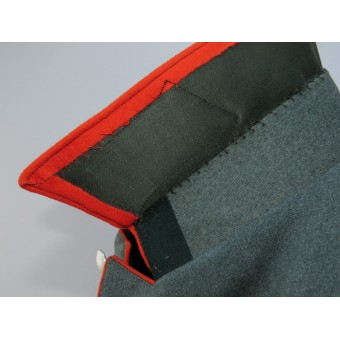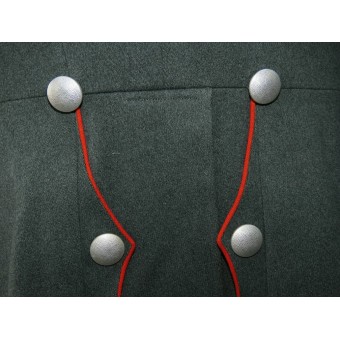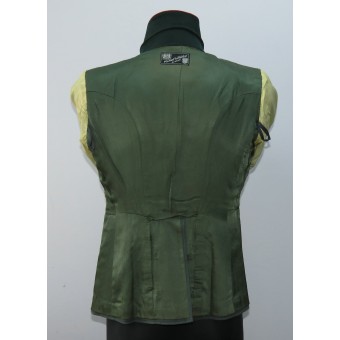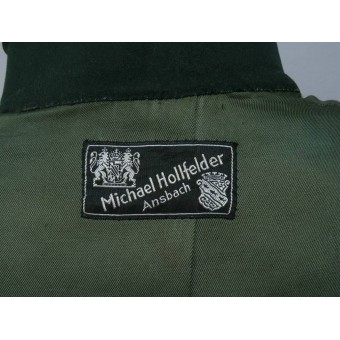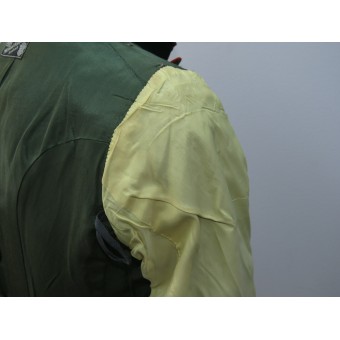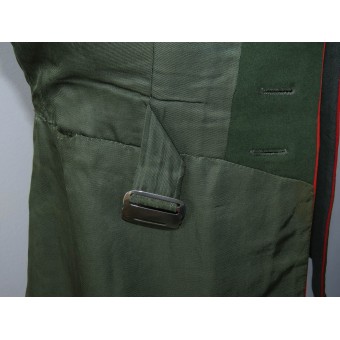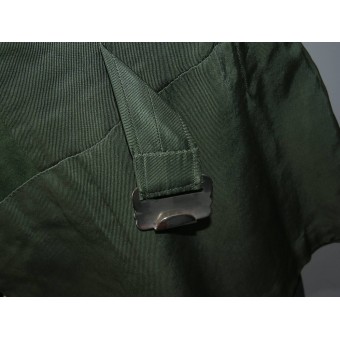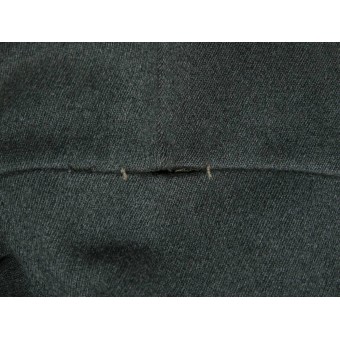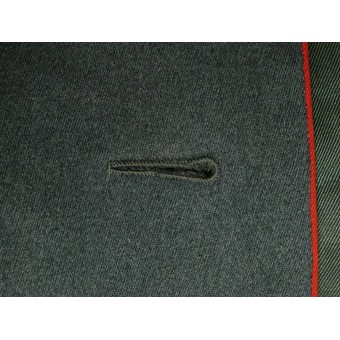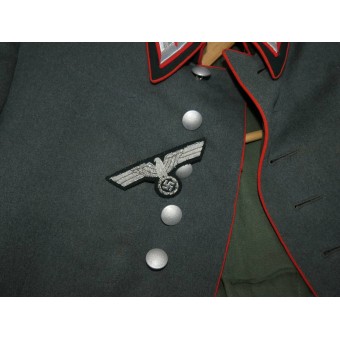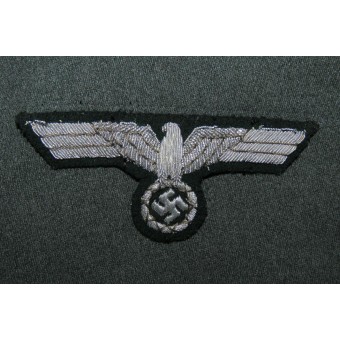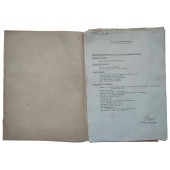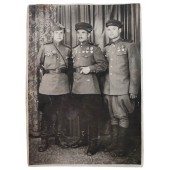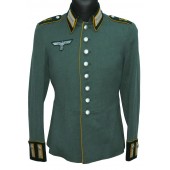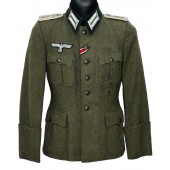112th Gebirgs-artillery regiment of the Wehrmacht officers tunic
German parade tunic Waffenrock of a lieutenant of the 112th Gebirgs-artillery regiment of the Wehrmacht. The tunic is made of a high-quality diagonal wool tricot cloth by Michael Hollfelder Ansbach. Inside the inner pocket, there is an order tag with the owner's name and rank: Herrn Fahnenjunker Willi Rogg Juli 1937 Ansbach. The tunic is in excellent condition with minor wear traces. The breast eagle was removed due to de-Nazification after the war. The collar tabs and sleeve tabs are machine attached, the shoulder straps with attached metal cyphers in gold color "112" are hand-sewn. Approximately 46 in size, for a puny and short man. An officer's breast eagle found in the inner pocket of his uniform can be sewn back on its old place by your request for extra fee.
The 112th Mountain Artillery Regiment was formed on August 1, 1938 at Wehrkreis XVIII. The regiment consisted of the first platoon created during the reorganization from part of the 5th light artillery regiment and the 2nd platoon of which was formed from the 7th light artillery regiment of the Austrian army. The first platoon was stationed in Graz and the second in Villach. Both are in the military district of the 18th century. The regiment was subordinate to the 3rd Mountain Rifle Division. During the Polish campaign, the regiment was stationed on the right flank of the army in the High Tatras and southern Polish forests and highlands. The regiment within the division has been sent to Lemberg. During the Battle of Lemberg ( Lvov), the regiment, along with the 3rd Mountain Division, was transferred to the west. April 13, 1940, the 3rd and 6th batteries were re-formed. Motorized III platoon left the regiment and was attached on September 2, 1941, as the fourth platoon of the 118 mountain artillery regiment of the 5th mountain rifle Division. For the occupation of Norway, the I. Platoon of the regiment was divided into S-Staffel and A-Staffel. During the occupation of Norway, parts of the 1st battery were assigned to the 138th Mountain Jaeger Regiment to occupy the Norwegian port of Trondheim. The soldiers were loaded onto the cruiser Hipper with weapons. On April 11, 1940, units of the 2nd battery (S-Staffel) were also warned about the mission in Norway and went to Narvik with four guns to support the 139th Gebirgsjager regiment. Here it was used in the defense of the city and the railway. A-Staffel was used in the II Platoon in the future, as replenishment for the II Platoon of the 113th Mountain Artillery Regiment. After the end of hostilities in Scandinavia, the regiment remained an occupying force in Norway. On August 15, 1940, the 7th battery was added to the regiment by renaming the special battery Wächter des Gebirgskorps Norway, which, until the winter of 41/42, was part of the 138 Gebirgsjager regiments. At the end of April 1941, a transfer to the Varanger Fjord as preparation for an occupation of the Soviet Union. From Petsamo, the regiment took part in the platoon's offensive against Murmansk. The attack was repelled by the Red Army on the Litsa River. At the beginning of 1942, the 3rd Mountain Division was withdrawn from the front and transferred to the Grafenwöhr military training ground in the Reich for reorganization and renewal. When the 3rd Gebirgsjäger division departed to the Reich, the 1st Platoon with the 1st and 2nd Batteries remained in the 139th Gebirgsjäger Regiment in Lapland and on January 15, 1942, became part of the 124th Mountain Artillery Division. The 1st Platoon was re-formed on March 1, 1942. For this, the 7th battery of the regiment and the 2nd battery of the 85th artillery regiment were used. After rest and reinforcement, the 3rd Gebirgsjäger division was transferred to the Leningrad region through Tallinn. In November 1942 it took part in fierce battles near Velikie Luki, and in early 1943 near Melitopol and Nikopol. On March 3, 1943, in Kufstein, also in the 18th Military District, the 3rd and 6th batteries were formed separately. At the beginning of 1944, the regiment was stationed in the south of Ukraine. By June 1944, the war zone had moved to the Eastern Carpathians. At the end of the war, the regiment was active in Upper Silesia
German parade tunic Waffenrock of a lieutenant of the 112th Gebirgs-artillery regiment of the Wehrmacht. The tunic is made of a high-quality diagonal wool tricot cloth by Michael Hollfelder Ansbach. Inside the inner pocket, there is an order tag with the owner's name and rank: Herrn Fahnenjunker Willi Rogg Juli 1937 Ansbach. The tunic is in excellent condition with minor wear traces. The breast eagle was removed due to de-Nazification after the war. The collar tabs and sleeve tabs are machine attached, the shoulder straps with attached metal cyphers in gold color "112" are hand-sewn. Approximately 46 in size, for a puny and short man. An officer's breast eagle found in the inner pocket of his uniform can be sewn back on its old place by your request for extra fee.
The 112th Mountain Artillery Regiment was formed on August 1, 1938 at Wehrkreis XVIII. The regiment consisted of the first platoon created during the reorganization from part of the 5th light artillery regiment and the 2nd platoon of which was formed from the 7th light artillery regiment of the Austrian army. The first platoon was stationed in Graz and the second in Villach. Both are in the military district of the 18th century. The regiment was subordinate to the 3rd Mountain Rifle Division. During the Polish campaign, the regiment was stationed on the right flank of the army in the High Tatras and southern Polish forests and highlands. The regiment within the division has been sent to Lemberg. During the Battle of Lemberg ( Lvov), the regiment, along with the 3rd Mountain Division, was transferred to the west. April 13, 1940, the 3rd and 6th batteries were re-formed. Motorized III platoon left the regiment and was attached on September 2, 1941, as the fourth platoon of the 118 mountain artillery regiment of the 5th mountain rifle Division. For the occupation of Norway, the I. Platoon of the regiment was divided into S-Staffel and A-Staffel. During the occupation of Norway, parts of the 1st battery were assigned to the 138th Mountain Jaeger Regiment to occupy the Norwegian port of Trondheim. The soldiers were loaded onto the cruiser Hipper with weapons. On April 11, 1940, units of the 2nd battery (S-Staffel) were also warned about the mission in Norway and went to Narvik with four guns to support the 139th Gebirgsjager regiment. Here it was used in the defense of the city and the railway. A-Staffel was used in the II Platoon in the future, as replenishment for the II Platoon of the 113th Mountain Artillery Regiment. After the end of hostilities in Scandinavia, the regiment remained an occupying force in Norway. On August 15, 1940, the 7th battery was added to the regiment by renaming the special battery Wächter des Gebirgskorps Norway, which, until the winter of 41/42, was part of the 138 Gebirgsjager regiments. At the end of April 1941, a transfer to the Varanger Fjord as preparation for an occupation of the Soviet Union. From Petsamo, the regiment took part in the platoon's offensive against Murmansk. The attack was repelled by the Red Army on the Litsa River. At the beginning of 1942, the 3rd Mountain Division was withdrawn from the front and transferred to the Grafenwöhr military training ground in the Reich for reorganization and renewal. When the 3rd Gebirgsjäger division departed to the Reich, the 1st Platoon with the 1st and 2nd Batteries remained in the 139th Gebirgsjäger Regiment in Lapland and on January 15, 1942, became part of the 124th Mountain Artillery Division. The 1st Platoon was re-formed on March 1, 1942. For this, the 7th battery of the regiment and the 2nd battery of the 85th artillery regiment were used. After rest and reinforcement, the 3rd Gebirgsjäger division was transferred to the Leningrad region through Tallinn. In November 1942 it took part in fierce battles near Velikie Luki, and in early 1943 near Melitopol and Nikopol. On March 3, 1943, in Kufstein, also in the 18th Military District, the 3rd and 6th batteries were formed separately. At the beginning of 1944, the regiment was stationed in the south of Ukraine. By June 1944, the war zone had moved to the Eastern Carpathians. At the end of the war, the regiment was active in Upper Silesia


